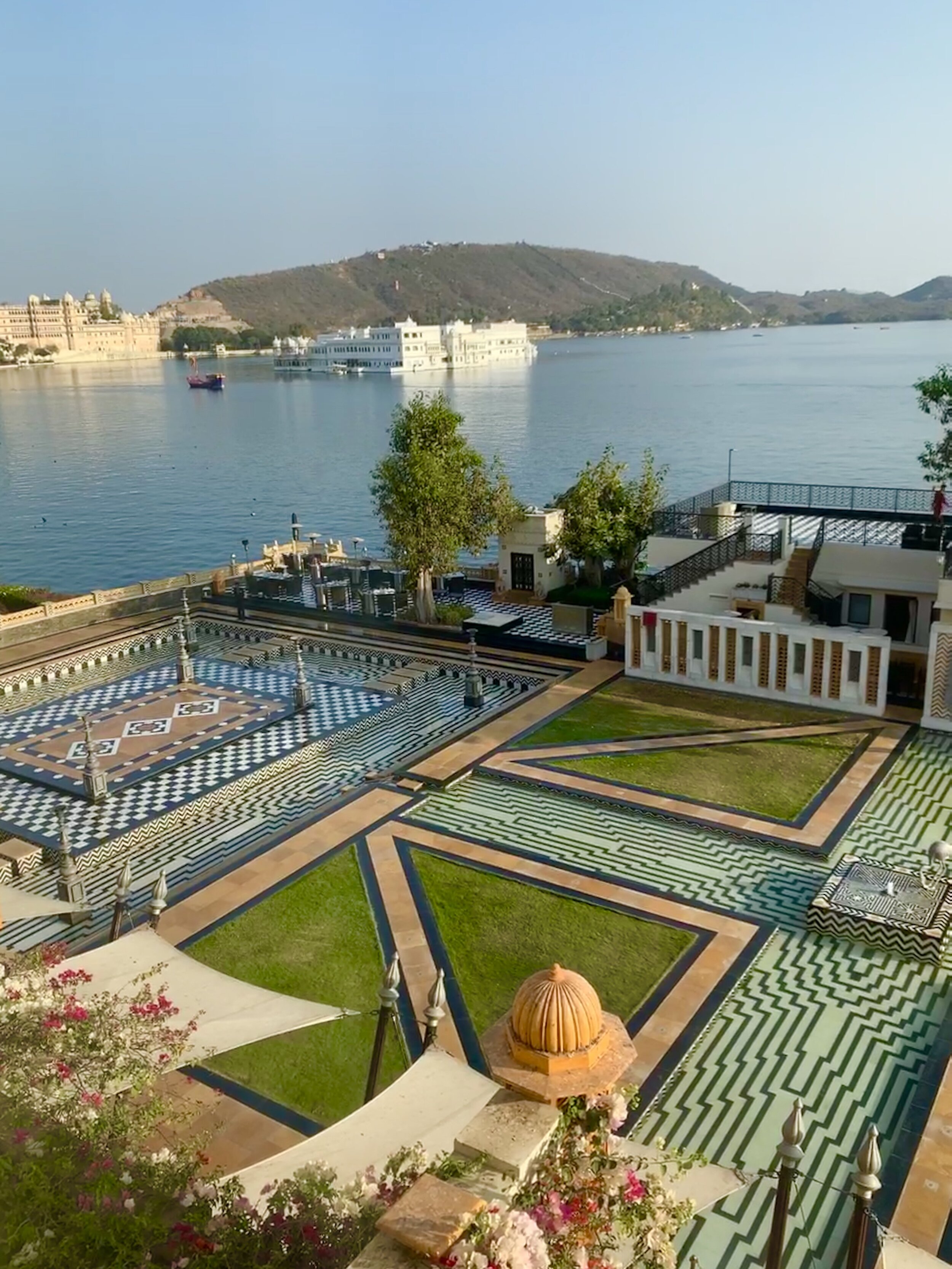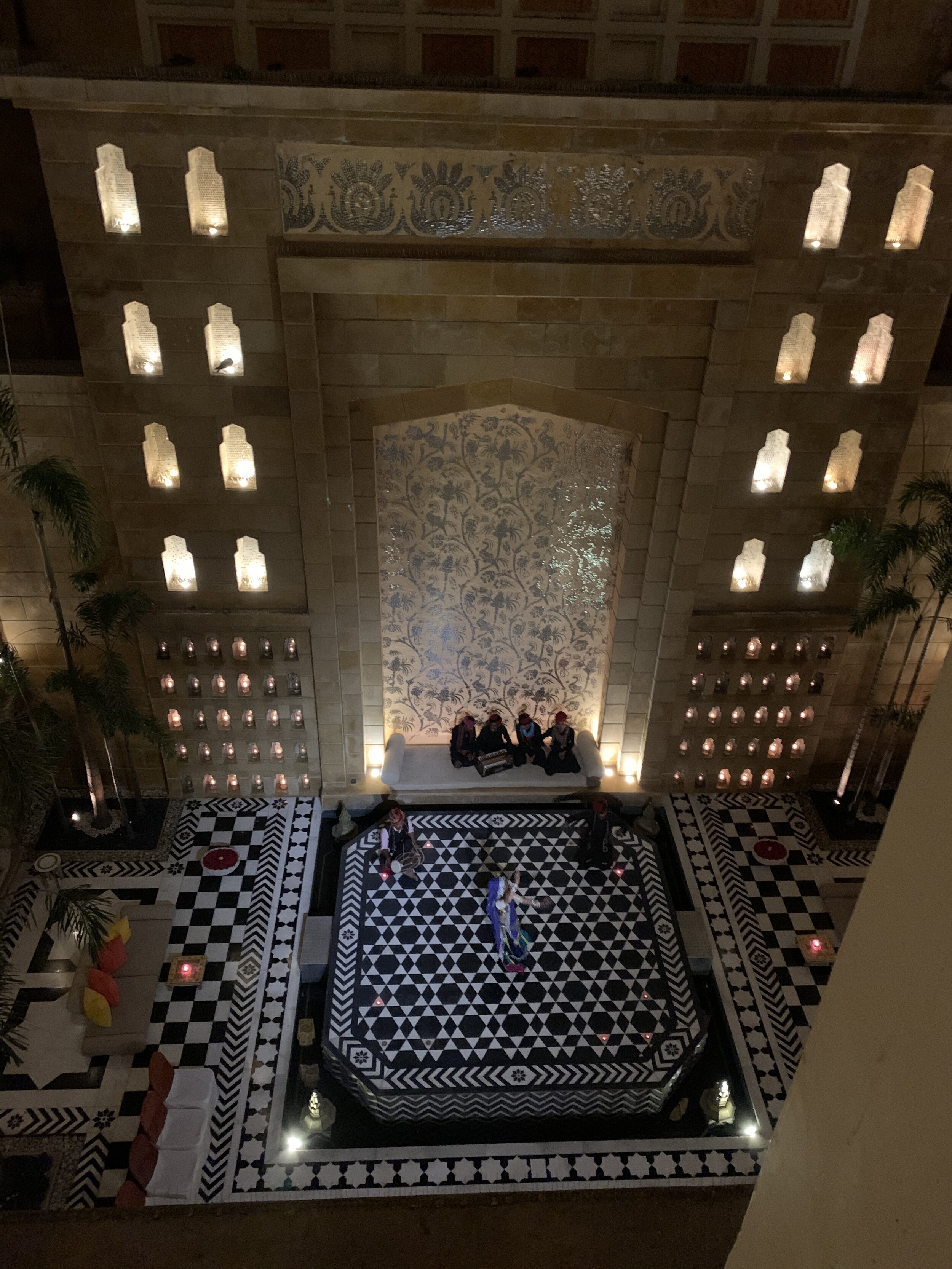A Breath of Fresh Air
View from our room at the Leela Palace; across the lake on the far left is the City Palace, in the center the Taj Lake Palace
Udaipur, the last stop on our India tour, was a literal breath of fresh air. We had begun our trip two weeks ago in Delhi, where the air equality on our arrival was rated as “very unhealthy.” During our stay there it worsened to “extremely unhealthy.” Throughout our tour, through Varanasi, Agra and Jaipur, the best air quality we got was just plain “unhealthy.” In Udaipur, we found the air clear and clean, and very refreshing.
After four consecutive Taj hotels, which were all exceptionally good, we were destined here for the Leela Palace, a property I had chosen based on its selection by the readers of Travel+Leisure Magazine as the top hotel in the world. Color me skeptical before arrival, convinced by departure. Our arrival itself was extraordinary. It began with a peaceful boat ride across the calm waters of Lake Pichola. We were greeted at the hotel’s landing by a small army of staff and management, serenaded by a trio of musicians and showered with rose petal confetti as if we had just won a championship. At the Leela Palace you are taken directly to your pre-assigned room for refreshments and completion of the check-in process—very civilized.
My own greeting was over-the-top, as it included a welcome dessert tray that referenced a travelogue of one of my previous trips and a reproduction of a photograph of me with my family taken on a visit to Barcelona a few years ago that was found in my bio. Obviously, they had mistaken me for someone who mattered. It was both flattering and embarrassing, since I am clearly in no sense worthy of such attention.
Music and dance of Rajasthan in the dinner atrium of the Leela Palace
As long as I am dwelling on the hotel, let me continue. It is absolutely stunningly beautiful. First of all, its setting. Gazing away from the hotel, the mirror-like lake is ringed by green mountains, with the old city and its crowning palace on the left. The famous Taj Lake Palace Hotel sits in the lake, slightly to the right of the City Palace. In the middle lies the Jag Mandir, an island palace now used for royal and wanna-be-royal weddings. The ubiquitous Shah Jahan hid himself from his father for four years in the Hindu temple following a failed attempt to over-throw him. To the far right is the luxury Oberoi Udaivilas Hotel and above it on a distant mountaintop the outline of the nineteenth century Monsoon Palace.
The scene is equally stunning at night, when all these palaces and palatial hotels are lighted. We were all reminded of the lakes of northern Italy, where grand old hotels sit along the shores of Como, Garda and Maggiore. Lake Pichola is their worthy competitor.
The hotel’s architecture is designed for drama, with a soaring, open-air interior atrium and sail-like awnings along the south-facing outdoor dining terrace. The pool and grounds are inviting and visually stunning. Lush landscaping, visited by melodious birds and playful monkeys, helps fill-out an environment that holds guests’ attention to detail while at the same time relaxing the body and spirit. This a creation of the well-known architect Bill Bensley, American-born, Harvard-educated and Bangkok-based. He has designed many of world’s more cutting-edge hotels. His personal website is a fascinating read.
Service throughout the property is thoughtful, gracious and ever-present. It was rare to move about without a staff member offering to accompany you to your destination. With nearly 300 staff and only 80 rooms, under-service was not a possibility. The food was the best we had during our time in India. In short, the experience of staying there was to feel what it must have been like to be a guest in a royal palace.
A break from touring in the rooftop courtyard of the City Palace
I am not a great fan of polls. As for hotels, there are many truly extraordinary ones to be found all around the world. Trying to rate them seems subjective at best and pointless at worst. I do, however, conclude our tour of India with the conviction that any such listing or ranking of the world’s best would have to include the Leela Palace Udaipur.
The tourist highlight of Udaipur is the aforementioned City Palace. It sits on a commanding rise above the lake and the old town. The views from its higher levels are even more dramatic than those from the lake-level hotels. A major portion of the whole complex has been converted into a museum that the public can access. It offers a glimpse into the lives of the maharani. And what a life they led, and still lead! One exhibit is a treasure of crystal that had been ordered by the reigning king in the late nineteenth century. It was a tall order, and before its shipment from England was completed, the king died. This was seen by the royal family as a bad omen, so the crates of crystal were left in a basement and never opened for more than a hundred years. Now we can see what state of the art crystal—not just lamps and stemware, but full-size furniture items as well—looked like in the 1800s. The current maharajah also maintains a vintage car collection which can be visited, but we decided that an hour by the hotel pool would be time better spent.
The intricate carvings of the Jagdish Temple
Our first tour in Delhi, what seems like long ago, started with an introduction to Hinduism. We ended our tour in Udaipur with a deeper view. We visited the ancient Jagdish Temple at mid-day and listened to beautiful hymns chanted by worshippers who were completely self-led. In the late afternoon, a priest came to a preserved shrine to the Hindu god Shiva on the hotel property and conducted a blessing ceremony for just the four of us. Our final day here included a stop at the ruins of the tenth century temple at Shahasra Bahu, followed by a visit to the Ekling Ji complex of 108 temples just outside of Udaipur. The former allowed not only no shoes or socks, but no cell phones or cameras; thus, I have nothing more to share about this stop. Hinduism is an ancient religion with many gods, many stories and many off-shoots such as Buddhism, Sikhism and Jainism. It is practiced today by a billion people. We learned so much about Hinduism yet barely scratched the surface of it.
We left the clean air and warm dry weather of Udaipur for the freezing cold and snow of Bhutan. Our two weeks in India were a wonderful experience, one that left us thinking about the many new parts of India will still have to discover in our next visit.




